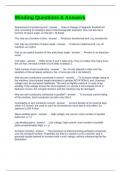Winding Questions & Answers
Requirement of producing emf - answer Rate of change of magnetic flux/field wrt
time, according to Faraday's laws of electromagnetic induction. Flux can also be a
function of space angle, so that phi = f(t,theta).
Flux only as a function of time - answer Produces transformer emf, e.g. transformer
Flux only as a function of space angle - answer Produces rotational emf, e.g. dc
machine, ac motors
Flux as an explicit function of time and phase angle - answer Present in an induction
motor
Coil sides - answer Refer to the S and F sides only. Thus no matter how many turns
the coil has, the total number of coil sides is always 2.
Total number of arm conductors - answer No. of coils (placed in slots over the
periphery of the armature surface) x No. of turns per coil x coil sides(2)
Why are arm conductors connected in series? - answer To increase voltage rating of
the machine, since greater length translates to greater ROTATIONAL emf. However,
voltage can't be increased indefinitely. The mica is slightly undercut. In case of lap
winding, if the voltage across the mica segment, i.e. across a coil exceeds 20-22 V,
flashover occurs, the coil gets shorted, and the machine may be damaged.
Why are arm conductors connected in parallel? - answer To increase current rating
of the machine. Each conductor can take only 200 A.
Constraints on arm conductor current - answer Current density of Cu must be kept
within 4-5 A/mm2, but cond cs can't be increased too much due to skin effect. So
optimum is 200 A max.
Wave winding specs - answer High voltage, low current, since number of parallel
paths low, a = 2
Lap winding specs - answer Low voltage, high current, since number of parallel
paths proportionately high, a = p
Armature winding - answer The procedure of interconnecting armature conductors
over the armature surface. Properties are that it is closed in a DC machine, and is
generally double layered to increase both v and i ratings, without unbalancing the flux
distribution.
, Why can't layers of arm conductors be increased indefinitely? - answer Problem of
flux penetration - due to the presence of air, the voltage induced in the lower layers is
always less than that in the upper layer. Since a coil has two sides, placing one in a top
layer and the other in a bottom layer assures an equal distribution, but more will upset
equilibrium. If such coils with unequal voltages are connected in series, circulating
currents will flow.
Pole pitch - answer Peripheral distance or separation between identical points on
two consecutive poles over the armature surface. Maybe in terms of length, or coil
sides. Generally length. Given by pi*D/p length, or (total no. of conductors/p) coil sides.
For wave, it is (total conductors +-1)/p.
Coil span - answer Peripheral distance or separation between the two sides of a
single coil in terms of no. of coil sides. If > = < pole pitch, termed over, full and
under/short/corded pitched. Generally full is used in DC to get max voltage. If other,
becomes e(1+cosa). Voltage decreases as a is changed from 0. At 90, the voltage
induced in the other side of coil = 0, hence this is neutral plane.
Back Pitch Yb - answer Peripheral distance or separation between the two sides of
the *same* coil, i.e. Si(odd) to Fi(even), measured at the back of the armature. Always
odd, since difference between odd and even.
Front Pitch Yf - answer Peripheral distance or separation along coil sides between
the two terminals connected to the same commutator segment, i.e. Fi(even) to
Si+1(odd), measured at the front of the armature. Always odd.
Commutator Pitch Yc - answer Peripheral distance between two commutator
segments connected to the two terminals of the same coil. In lap, it is 1 comm segment.
In wave, it is twice pole pitch, i.e. (c+-1)*2/p. Positive indicates progressive winding,
while negative is for retrogressive winding.
Resultant pitch Yr - answer Peripheral distance or separation between two
consecutive starting sides of coils(in terms of comm segments). Given by (Yb-Yf),
always even. In lap, +-2. In wave, 4(C+-1)/p.
Progressive Lap - answer Direction of tracing winding is same as direction of
progression of winding. Preferred in small applications since safer. Yb>Yf.
Retrogressive Lap - answer Direction of tracing the winding is opposite the direction
of progression of winding. Preferred in industrial applications since the -1 commutator
pitch equates to a saving of copper. However, because conductors cross more, the
rotation of armature may cause lateral displacement of crossed conductors, leading to
wearing of insulation and ultimately, a shorting. Yf<Yb




